Small boats can troll up pelagics with the big boys at a fraction of the cost. There’s less margin for error, especially if the weather suddenly turns against you, but I’ve taken scores of diminutive fishing boats offshore since the mid-’70s.
Size, of course, is relative. I define “small” as any seaworthy 20- to 27-foot craft (with V bottom, deep freeboard and cockpit, fresh and reliable power, and standard fuel tank that supports eight to 10 hours of cruising range) that can safely transit an inlet and venture at least 20 miles offshore.

Depending on your homeport, your local offshore grounds could put you right in the thick of things. Or you might have to reach a bit farther offshore to cross paths with migrating pelagic species. Fortunately, many boats in the aforementioned size range are eminently trailerable, so you can follow the fish up and down the coast to shorten your ride to the promised land.
I rigged up MarCeeJay No. 14, a 228 EdgeWater center-console; all versions have ranged in size from 19 to 27 feet, so I write here with the benefit of five decades of experience on the subject. I’ve developed a pretty good feel for what works offshore (loosely defined as losing sight of land and landmarks) and what doesn’t, so jump on board and let’s break down what small boat trolling is all about.
Trolling is a Proven Fishing Method
Big boat or small, the science of trolling is fairly straightforward but far from simple. Your vessel’s engine(s) produce a variety of mechanical noises: two-stroke or four-stroke in-water exhaust, a bubble trail from the spinning prop as it chews up the seas, and the splashing of the hull as it slides through offshore seas at displacement speeds. In short, your boat produces a white-water wake, acting like a big self-powered teaser.
Pelagic species like tuna, billfish, mahi, wahoo and others migrate from faraway waters, and when they pass through an area, they are typically scouting favorable forage conditions at the usual hot spots like wrecks, rock piles, fathom curves, canyon or shelf edges, weed lines, eddies, and areas of whale and porpoise activity, water-color changes and temperature breaks. Just as with freshwater bass fishing, being successful in offshore or distant canyon waters is all about finding fish-aggregating structure and knowing what to do when you find it. Trolling at speeds in the 6- to 9-knot range in nearshore and canyon blue waters will bring a variety of baitfish into your wake, first out of curiosity about the sound and sight of your vessel, and then to leverage the opportunity to hide in the white water, especially if predator fish are in the neighborhood.
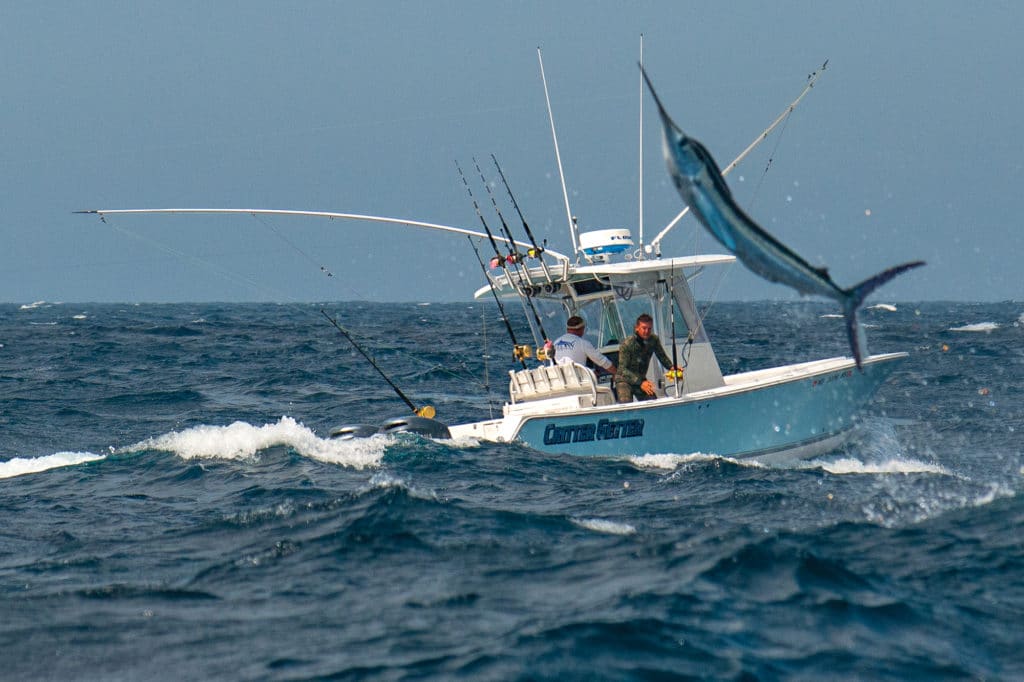
Why Trolling Attracts Fish
Why Trolling Attracts Fish
To get a scientific spin on this phenomenon, I reached out to Dr. Mitch Roffer, the founder of Roff’s Ocean Fishing Forecasting Services. Says Roffer, “Both baitfish and pelagics are attracted to the sound and sight of your vessel as it plows along at trolling speeds. It’s easier for forage and predators to maneuver in and out of the white water of your boat’s slower trolling wake than it is at a 25-knot cruising speed.
“Since sound travels five times faster and farther underwater than above the waves at sea level,” Roffer says, “once baitfish and species that pursue them have found the source of the sound and are drawn in to investigate, the boat wake offers a visual stimulus, providing both shelter and camouflage allowing baitfish to slip in and out of the bubbles and shadows. This helps them avoid being prey for hungry pelagics, which are also attracted to the sound and sight of a boat’s trolling wake as a potential food source, looking for those same baitfish.”
I have observed pods and schools of baitfish in my vessel’s wake on numerous occasions only to see them suddenly and unceremoniously engulfed by the explosion of a hungry tuna, mahi, mako or billfish. Roffer’s explanation backs up many of my experiences on the water — a mix of the right baits, trolling patterns and speeds will attract fish.

Small Boat Trolling Setup
Transforming your 20- to 27-footer into an efficient trolling fishing setup requires some specific boat additions, especially in the form of flush-mount and vertical rod holders. I believe that most boats, even those “built for fishermen,” simply do not have enough standard rod holders. Experience has taught me that the bare-bones minimum setup for a successful trolling platform requires three flush-mount rod holders per side, with an equal number of vertical rod holders set in a leaning post, hardtop or T-top, plus additional vertical rod holders on the hardtop-tower legs.
Installing a few additional rod holders across the transom, in the form of flush-mount units in the transom bulkhead cap or in racks across the outboard side of the transom well, will always create a valuable asset. While 95 percent of small boats probably have minimal difficulties mounting six flush rod holders, the vertical-rod-holder part of the equation requires some sort of a fixed top, whether in the form of a hardtop, half-tower, T-top or radar arch.
Here’s the reason additional rod holders are so important: There’s not a lot of excess room on a small boat trolling spread, and usable cockpit and storage space is at a premium. If you are trolling six or seven rods and two of them get hit, what do you do with the others? Extra setups get reeled in and stowed out of the way so the anglers can fight the fish totally unencumbered, without tripping over or stepping on expensive offshore tackle. Enough rod holders allow a place for everything.
One of my specialties as a boat captain is the ability to troll seven rods in my small boat trolling spread without using outriggers and while avoiding tangles in most sea and wind conditions. Although we’ll explore this setup in more detail in the following section, I can accomplish this task through the use of two affordable accessories. One is a pair of 0-degree rod holders, which I install on either side in the forwardmost position of the gunwale covering boards.
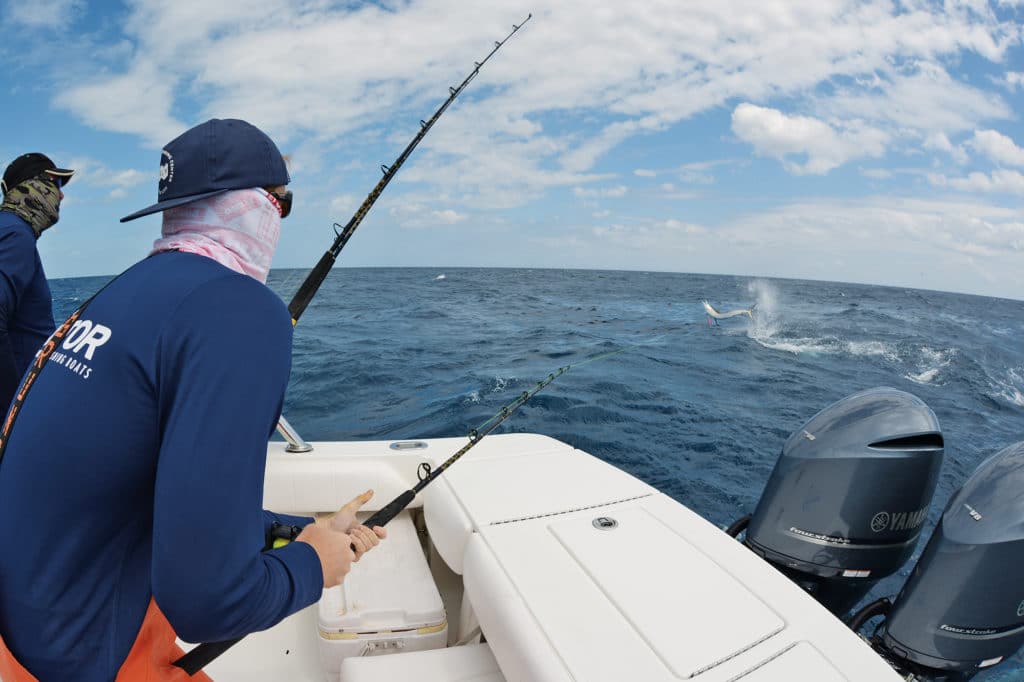
Small Boat Fishing Storage
The second part of the equation is a set of rod riggers, which can go by a variety of different trade names (currently manufactured by Taco, Smith, Tigress and others), but all perform the same function. These rod riggers, manufactured from stainless steel, chrome-over-brass or anodized aluminum tubing, are designed to increase the horizontal reach of your trolling baits. They accomplish this task by using the length of the rod to effectively spread the lures or baits apart on either side of your vessel’s hull, similar to how an outrigger would function, but without the drop-back after a strike. The rod riggers require a through-bolted metal rod holder as the base and typically feature a short length of safety line that attaches to the harness lug of your reel on one end and to a cleat on the opposite end.
I’ve used rod riggers on my boats for over three decades and will tell you that they work just as advertised. Even though I have a few extra pairs of these as backups in my travel kit, I still use original aluminum-tube Reliable Gaff rod riggers purchased in the early 1990s. The rod riggers have contributed to hundreds of tuna, mahi, wahoo, white marlin and other pelagics I’ve caught off Long Island while mostly trolling for tuna.
As a final step to improve the efficiency of your trolling vessel, I would recommend adding a trio of horizontal storage racks under the gunwales — not so much for stowing rods (they get beat up down there) as for keeping your gaffs, tagging sticks and boat hooks out of the way. On my boat, I reserve flush-mount, leaning-post and overhead rocket-launcher rod holders for rods.
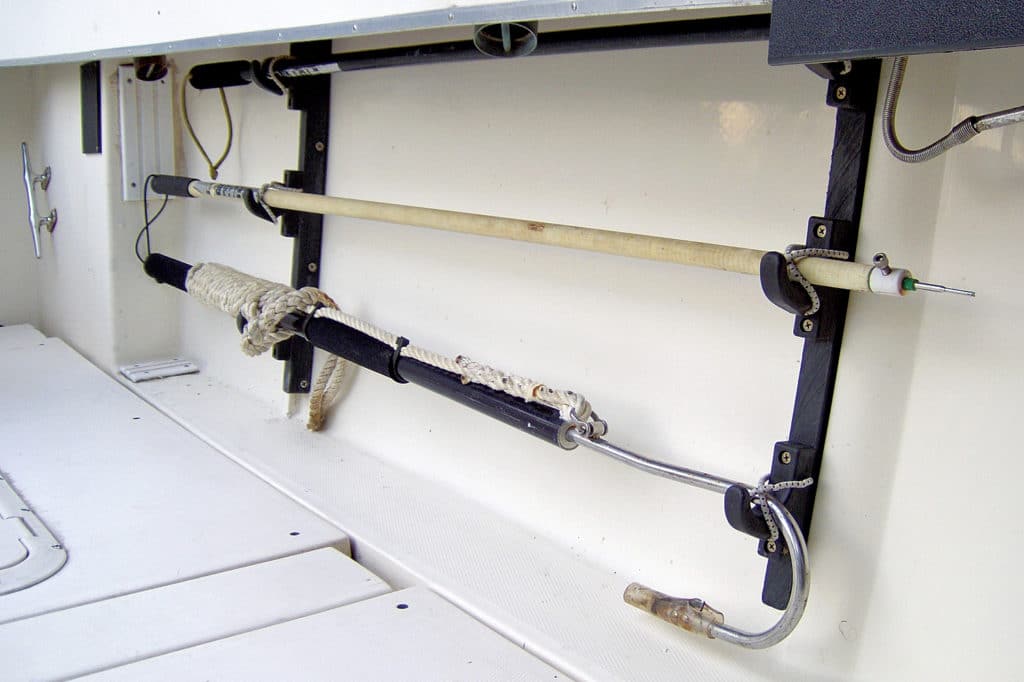
Create the Best Wake for Trolling When Fishing
You’ve no doubt heard dockside arguments about how one angler’s boat has a beautiful trolling wake and brings fish up from the depths like the Pied Piper, while other anglers can’t seem to catch a cold with their trolling efforts. These thoughts might have some credibility when discussing a 50-footer compared to a 60-footer, each with diesel power that produces a lower-frequency hum. None of that really applies, however, to small-boat fans limited in their propulsion options. Ninety percent of vessels in the 20- to 27-foot range are outboard powered. That changes the narrative to which sound is more effective: the sewing-machine staccato of a two-stroke, or the more serene exhaust of a four-stroke? The answer is likely a wash.
To determine if the effectiveness of a trolling wake is a major consideration when designing a small outboard-powered boat, I contacted David Neese, vice president of engineering at Grady-White Boats. With 30 years of experience and dozens of new designs developed under his watch, Neese is a great source for an honest answer to this question.
“A clean trolling wake is an important aspect of any fishing boat, but it’s typically the by-product of other design factors,” says Neese. “When designing a new boat, a number of factors are at the top of the list, including the vessel’s constant and variable loads and how these affect the centers of gravity and buoyancy. The consistent strong points of Grady’s SeaV2 hulls are a soft ride and excellent stability.”
I have learned a few tips and tricks that you can employ to control your boat’s wake. Conceptually, your vessel is a self-powered teaser, producing a constant stream of bubbles attracting both bait and predators. If your wake produces too much white water, the forage fish might have a great place to hide, but the pelagics will not see your baits. The ideal small-boat wake produces a jet stream of deep exhaust bubbles from the prop wash, plus a secondary stream of surface bubbles emanating at a 45-degree angle from the outside edges of your boat. Together, these streams are called chine wash.
In theory, you should observe a pair of clean-water “lure channels” on either outboard side of the prop wash and inboard of the chine wash. This scenario is the optimum setup — a bubble stream to attract bait and predators, with clear water on either side of the prop wash for your lures to be clearly seen dancing in the wake. When rigging for tuna trolling, make sure you have those clean-water lanes in your wake.
Raising the trim on your engine outdrives and bringing down the trim tabs will create more white water in your boat’s wake. Conversely, tucking your engine drives down and taking your trim tabs up will produce less. If you have a twin-engine setup and still produce too much white water even after making these adjustments, tilt one engine out and use the other for trolling to produce less white water.
This wake-adjustment advice is for monohull craft; catamarans are a totally different story. Cats produce white water from one side to another, courtesy of the props that are set farther outboard, toward the chines, and of a tunnel on the centerline that agitates water like a passenger cruise ship. This makes trolling baits and lures close to the transom (which can be seen by predators) a real challenge, requiring a totally different trolling approach.
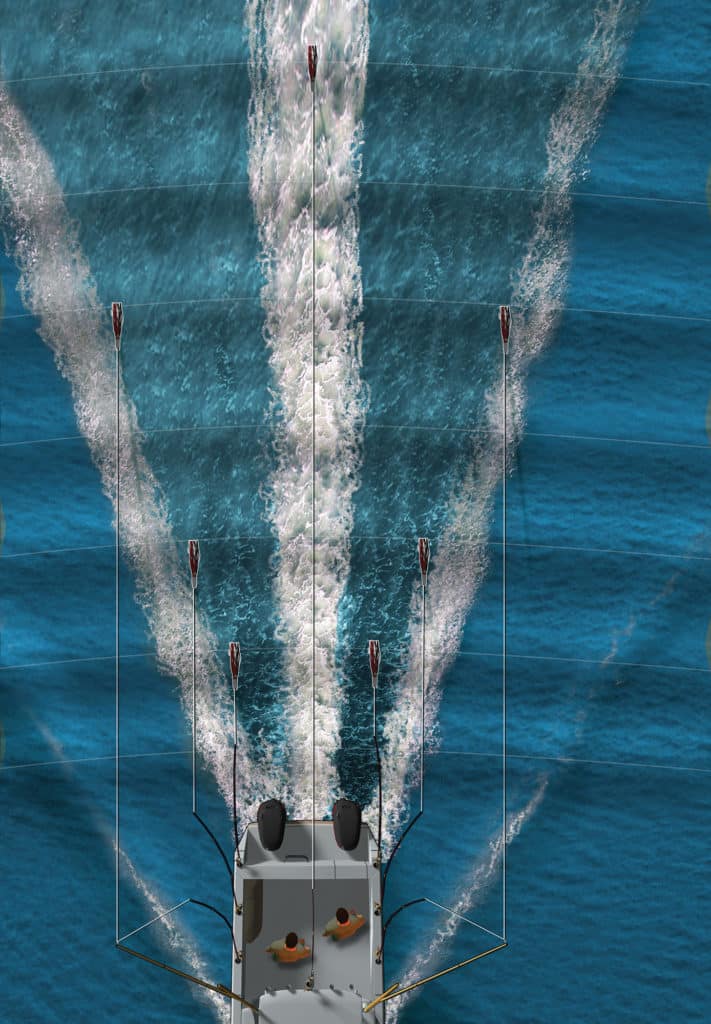
Preferred Small Boat Trolling Spreads
You’d be amazed, when trolling offshore, how close to your boat’s transom a hungry pelagic will come to get a meal. I have caught yellowfin, bluefin and wahoo 15 feet behind the transom, in the first wake. The challenge is to keep baits and lures down in the water and make them look natural.
My standard seven-rod trolling setup includes two rods positioned in the aft flush-mount gunwale rod holders, set in the second wake about 30 to 40 feet behind the boat, using short flat-line clips such as AFTCO’s Roller Trollers or Rupp’s Zip Clips. These can be attached via a short halyard to your boat’s ski or lifting eyes on the transom or aft cleat, or in a pinch, they can be tied under the reel seat of your trolling rod. Simply looping the clips around the preferred mount will keep it in place. The flat-line clips perform two functions: keeping your bait swimming down the face of the appointed wave in the most natural manner, and allowing an audible snap when a predator has taken the bait.
I put a second duo of trolling rods in the middle pair of flush rod holders that are angled 45 degrees outboard and set in the third wake, about 75 to 90 feet aft. The lures on these rods are attached to identical flat-line clips sporting a longer halyard and secured in a similar fashion. A third pair of trolling rods is deployed using the aforementioned rod riggers (or outriggers if you have them) for additional separation. These are placed in the fifth wave, which might be anywhere from 125 to 150 feet aft in your boat’s wake. A shotgun rod is placed in the hardtop above all of the commotion, and is positioned in the eighth wave or even farther back, with 100 yards behind the boat being an ideal position.
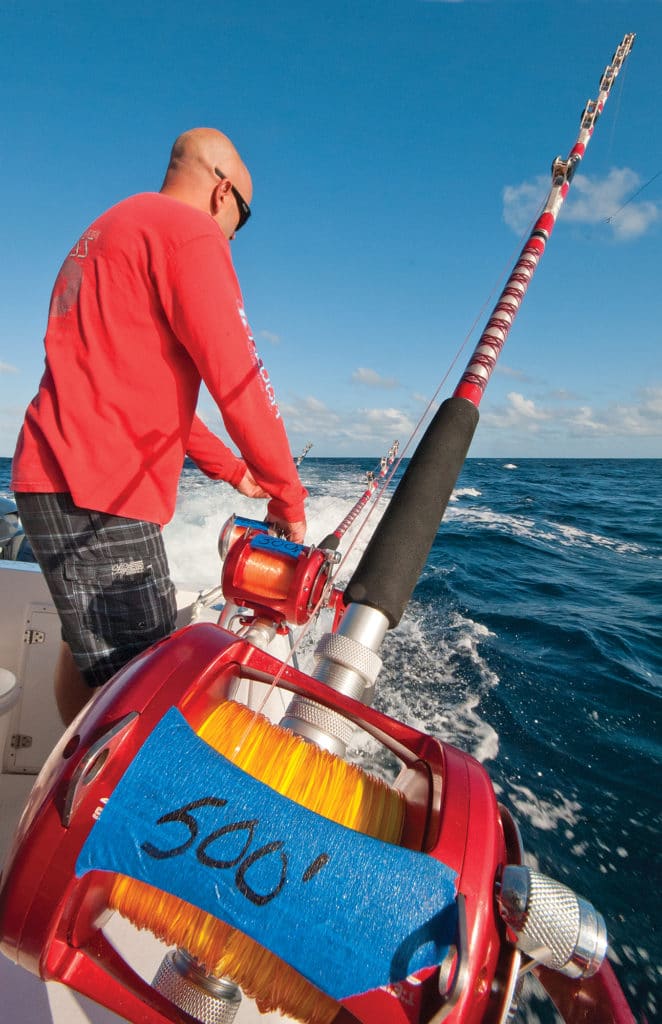
The Ideal Trolling Setup with Lures
One way to help avoid tangles with your flight patterns is to put bird teasers ahead of the long shotgun lure and the rod-rigger lures. This enables you to observe the wake and the lures’ positions in it, and it helps guide your steering hand when making turns. The best trolling pattern for your boat should be limited only by your imagination. If you have both a short and long rigger setup, you should be able to troll up to eight or nine outfits. I like to run a serpentine course, making a slight turn to port or starboard every few hundred yards. This causes baits to drop and slow down on one side and to rise and speed up on the opposite side, in addition to making your offerings swim in and out of the white water.
The ideal trolling lure setup will vary from trip to trip, based on the time of the season and available forage. My setup includes Stalker Jets up close; either squid or Green Machine spreader bars or daisy chains on the second set of rods; single Green Machines, skirted ballyhoo or daisy chains off the rod riggers; and my all-time favorite, a large bird and Green Machine running 100 yards aft. You can choose to mix and match dredges, bars, ballyhoo or whatever based on where you call homeport and the intended species, but the point is to make as much commotion in your wake as possible to bring the fish up from the depths to your spread.
If I’m looking for wahoo, I might eschew the baits running in the second wave and move a pair of Braid Marauders, Little Speedies or Yo-Zuri Bonitas up into the first-wave position 15 to 20 feet aft of the transom. If you’re lucky enough to hook up using these outfits, be prepared for a violent strike.
When blessed by fishable weather, small boats can troll with the big boys most days. Use some of the tips and techniques discussed here to improve your score offshore.

Marine Electronics Help When Trolling
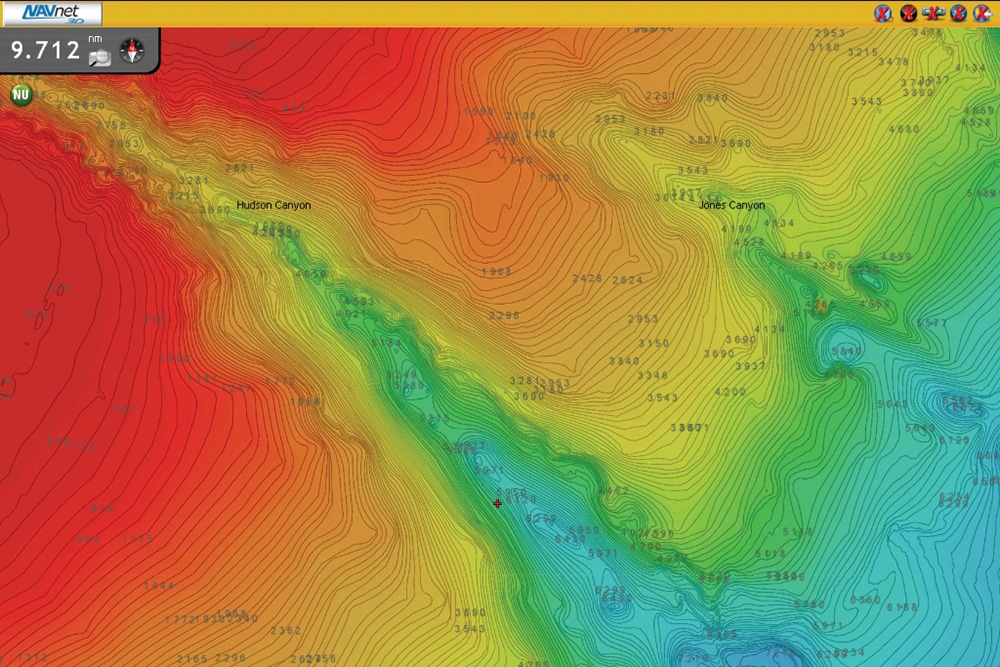
I contacted Si-Tex’s sales manager, Allen Schneider, to get a feel for how small-boat anglers can use electronics to improve their score offshore. Schneider suggests that fishermen add an automatic identification system (AIS) receiver to their vessel, not just for safety reasons when operating in the shipping lanes, but to catch more fish.
As of March 2016, all coastal draggers were required to have an AIS transponder on board. It’s a potential bonanza for small-boat trollers, since we all know that one of the rules offshore is that finding the draggers helps find the fish! Si-Tex’s Metadata dual-channel AIS receiver is reasonably priced and hooks up easily to your preferred chart plotter via an NMEA 2000 or 0183 connection.
Jeff Kauzlaric, from Furuno USA, mentions that “while bathymetric charts are all the rage for offshore and canyon anglers, deep drop-offs and radical edges can cause those curves to jam up into unintelligible black lines on your chart plotter’s screen.” One way to solve this problem is to employ depth shading, a feature found on most Furuno NavNet and TZtouch MFDs. Depth shading allows the operator to color-code different depth contours to paint a much clearer picture, which is especially useful on the smaller display-screen sizes found on small boats.








